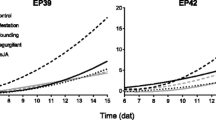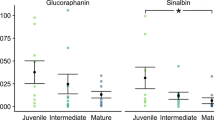Abstract
In a screenhouse experiment in southwest Mexico, we infested two maize cultivars, a land-race and a modern high-yielding variety, and two wild teosintes, Zea diploperennis and Zea mays parviglumis, with newly hatched larvae of the stemborer, Diatraea grandiosella. While subsequent damage levels, when corrected for differences in plant size, were highest in the wild perennial, Zea diploperennis, this taxon showed the lowest absolute and proportional reductions in growth and reproduction, i.e., it was most tolerant to the damage. Higher growth rates were not associated with tolerance. Rather, a greater number of tillers and leaves in the wild taxa allowed for compartmentalization of damage and greater developmental plasticity. These results, when combined with previous findings on effective defense patterns, indicate that tolerance in maizes and wild relatives may be positively associated with defense against stemboring by the same insect. Because the probable mechanisms for defense (tissue fiber) and tolerance (plant architecture) are unrelated, a positive association is contrary to the predictions of some optimal defense theories, which posit a negative relationship between tolerance and defense.
Similar content being viewed by others
References
Bilbrough CJ, Richards JH (1993) Growth of sagebrush and bitterbrush following simulated winter browsing: mechanisms of tolerance. Ecology 74: 481–492
Bloom AJ, Chapin FS, Mooney HA (1985) Resource limitation in plants — an economic analogy. Annu Rev Ecol Syst 16: 363–392
Chapin FS III (1980) Nutrient allocation and responses to defoliation in tundra plants. Arct Alp Res 12: 556–563
Chew FS, Rodman JE (1979) Plant resources for chemical defense. In: Rosenthal GA, Janzen DH (eds) Herbivores: their interaction with secondary plant metabolites. Academic Press, New York, pp 271–307
Chippendale GM, Mahmalji MZ (1987) Seasonal life history adaptions of a neotropical corn borer, Diatraea grandiosella. Insect Sci Appl 8: 501–506
CIMMYT (1989) Toward insect resistant maize for the Third World: proceedings of the international symposium on methodologies for developing host plant resistance to maize insects. CIMMYT, Mexico D.F.
Coley PD, Bryant JP, Chapin FS III (1985) Resource availability and plant anti-herbivore defense. Science 230: 895–899
Coughenour MB (1985) Graminoid responses to grazing by large herbivores: adaptations, exaptations, and interacting processes. Ann Mo Bot Gard 72: 852–863
Crawley MJ (1987) Benevolent herbivores? Trends Ecol Evol 2: 167–168
Crawley MJ (1989) Insect herbivores and plant population dynamics. Annu Rev Entomol 34: 531–564
Dirzo R (1984) Herbivory: a phytocentric overview. In: Dirzo R, Sarukhan J (eds) Perspectives on plant population ecology. Sinauer, Sunderland, Mass, pp 141–165
Donald CM (1968) The breeding of crop ideotypes. Euphytica 17: 385–403
Duncan WG (1975) Maize. In: Evans LT (ed) Crop physiology. Cambridge University Press, UK, Cambridge, UK, pp 23–50
Evans LT (1993) Crop evolution, adaptation and yield, Cambridge University Press, Cambridge, UK
Fritz RS, Simms EL (eds) (1992) Plant resistance to herbivores and pathogens: ecology, evolution and genetics, Chicago University Press, Chicago
Gold WG, Caldwell MM (1989) The effects of the spatial pattern of defoliation on regrowth of a tussock grass. 1. Growth responses. Oecologia 80: 289–296
Gomez KA, Gomez A (1984) Statistical procedures for agricultural scientists. Wiley, New York
Grubb PJ (1992) A positive distrust in simplicity — lessons from plant defences and from competition among plants and among animals. J Ecol 80: 585–610
Gulmon SL, Mooney HA (1986) Costs of defense and their effects on plant productivity. In: Givnish TJ (ed) On the economy of plant form and function. Cambridge University Press, Cambridge, UK, pp 681–695
Harper JL (1977) Population biology of plants. Academic Press, London
Hedin PA, Davis FM, Williams WP, Salin ML (1984) Possible factors of leaf-feeding resistance in corn to the southwestern corn borer. J Agric Food Chem 32: 262–267
Herms DA, Mattson WJ (1992) The dilemma of plants: to grow or defend. Q Rev Biol 67: 283–335
Holloway TE, Haley WE, Loftin UC (1928) The sugar-cane moth borer in the United States. USDA, Wasbington, D.C.
Juvik JA, Stevens MA, Rick CM (1982) Survey of the genus Lycopersicon for variability in a-tomatine content. Hort Sci 17: 764–766
Lee TD, Bazzaz FA (1980) Effects of defoliation and competition on growth and reproduction in the annual plant Abutilon theophrasti. J Ecol 68: 813–821
Luckmann WH (1982) Integrating the cropping system for corn insect pest management. In: Metcalf RL, Luckmann WH (eds) Introduction to insect pest management, 2nd edn. Wiley, New York, pp 499–520
Marquis RJ (1991) Evolution of resistance in plants to herbivores. Evol Trends Plants 5: 23–29
Marquis RJ (1992) A bite is a bite is a bite? Constraints on response to folivory in Piper arieianum (Piperaceae). Ecology 73: 143–152
Marshall C, Sagar GR (1968) The interdependence of tillers in Lolium multiflorum Lam — a quantitative assessment. J Exp Bot 19: 785–794
Maschinski J, Whitham TG (1989) The continuum of plant responses to herbivory: the influence of plant association, nutrient availability, and timing. Am Nat 134: 1–19
Mauricio R, Bowers DM, Bazzaz FA (1993) Pattern of leaf damage affects fitness of the annual plant Raphanus sativus (Brassicaceae). Ecology 74: 2066–2071
McKey D (1979) The distribution of secondary compounds within plants. In: Rosenthal GA, Janzen DH (eds) Herbivores: their interaction with secondary plant metabolites. Academic Press, New York, pp 56–134
McNaughton SJ (1992) Laboratory-simulated grazing: interactive effects of defoliation and canopy closure on Serengeti grasses. Ecology 73: 170–182
Meijden E van der, Wijn M, Verkaar HJ (1988) Defence and regrowth, alternative plant strategies in the struggle against herbivores. Oikos 51: 355–363
Mooney HA, Gulmon SL (1982) Constraints on leaf structure and function in reference to herbivory. BioScience 32: 198–206
Peairs FB (1977) Plant damage and yield response to Diatraea saccharalis (F.) and Spodoptera frugiperda (J.E. Smith) in selection cycles of two tropical maize populations in Mexico. PhD Dissertation, Cornell University, Ithaca
Rhoades DF (1979) Evolution of plant chemical defense against herbivores. In: Rosenthal GA, Janzen DH (eds) Herbivores: their interaction with secondary plant metabolites. Academic Press, New York, pp 4–48
Richards JH (1994) Physiology of plants recovering from defoliation. Proc XVII Int Grassl Cong 1993, Palmerston North, New Zealand, pp 85–94
Rosenthal JP (1993) Effects of life history, domestication, and agronomic selection on plant resistance to insects: maizes and wild relatives. PhD dissertation, University of California, Berkeley
Rosenthal JP, Kotanen PM (1994) Terrestrial plant tolerance to herbivory. Trends Ecol Evol 9: 145–148
Smith CM (1989) Plant resistance to insects: a fundamental approach. Wiley, New York
SYSTAT (1992) SYSTAT User's guide: statistics. Evanston, Ill
Trumble JT, Kolodny-Hirsch DM, Ting IP (1993) Plant compensation for arthropod herbivory. Annu Rev Entomol 39: 93–119
Wandera JL, Richards JH, Mueller RJ (1992) The relationships between relative growth rate, meristematic potential and compensatory growth of semiarid-land shrubs. Oecologia 90: 391–398
Watson MA, Casper BB (1984) Morphogenetic constraints on patterns of carbon distribution in plants. Annu Rev Ecol Syst 15: 233–258
Welter SC (1989) Arthropod impact on plant gas exchange. In: Bernays EA (ed) Plant-insect interactions. 1. CRC Press, Boca Raton, Fla, pp 135–150
Welter SC, Steggall JW (1993) Contrasting the tolerance of wild and domesticated tomatoes to herbivory: agro-ecological implications. Ecol Appl 3: 271–278
Zangerl AR, Bazzaz FA (1992) Theory and pattern in plant defense allocation. In: Fritz RS, Simms EL (eds) Plant resistance to herbivores and pathogens: ecology, evolution, and genetics. University of Chicago Press, Chicago, pp 363–391
Author information
Authors and Affiliations
Rights and permissions
About this article
Cite this article
Rosenthal, J.P., Welter, S.C. Tolerance to herbivory by a stemboring caterpillar in architecturally distinct maizes and wild relatives. Oecologia 102, 146–155 (1995). https://doi.org/10.1007/BF00333245
Received:
Accepted:
Issue Date:
DOI: https://doi.org/10.1007/BF00333245




